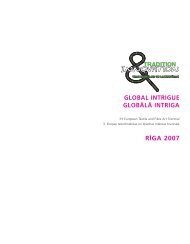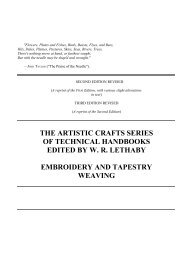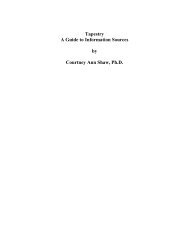THE FINE ART OF TAPESTRY WEAVING
THE FINE ART OF TAPESTRY WEAVING
THE FINE ART OF TAPESTRY WEAVING
You also want an ePaper? Increase the reach of your titles
YUMPU automatically turns print PDFs into web optimized ePapers that Google loves.
<strong>THE</strong> <strong>FINE</strong> <strong>ART</strong> <strong>OF</strong> <strong>TAPESTRY</strong> <strong>WEAVING</strong><br />
<strong>TAPESTRY</strong> 2008<br />
The Australian National University School of Art Gallery
Front Cover images: Susan Mowatt, Silk, Fiona Rutherford, Äino Kajaniemi, Warp, Yasuko Fujino, Susan Martin Maffei
<strong>THE</strong> <strong>FINE</strong> <strong>ART</strong> <strong>OF</strong> <strong>TAPESTRY</strong> <strong>WEAVING</strong><br />
Contemporary tapestry by selected artists.<br />
Yasuko Fujino<br />
Susan Martin-Maffei<br />
Fiona Rutherford<br />
Archie Brennan<br />
Jane Kidd<br />
Äino Kajaniemi,<br />
Sue Lawty<br />
Sara Lindsay<br />
Susan Mowatt<br />
Japan<br />
USA<br />
England<br />
USA<br />
Canada<br />
Finland<br />
England<br />
Australia<br />
Scotland
Äino Kajaniemi<br />
Installation view<br />
Photographer: Stuart Hay
The Fine Art of Tapestry Weaving<br />
The exhibition explores relationships between fine art,<br />
tapestry and weaving in the works of nine contemporary<br />
artists from a diverse range of backgrounds, training and<br />
cultural perspectives.<br />
As an emerging art in Australia, tapestry has a short history,<br />
developed through the contemporary craft movement,<br />
community tapestry projects, the Victorian Tapestry<br />
Workshop, individual artists and arts organizations. The main<br />
influences are from European traditions dating back to the<br />
medieval period when tapestry narratives were produced<br />
in abundance. During the Renaissance, Raphael’s tapestry<br />
cartoons depicting the “Acts of the Apostles” established a<br />
close relationship between teams of tapestry artisans and<br />
painters. This way of working continued through to William<br />
Morris who brought about changes in design for tapestry,<br />
refined the use of colour and reinstated tapestry as an art<br />
form in its own right. French painter Jean Lurcat and Scottish<br />
master weaver Archie Brennan then developed and shaped<br />
the European and related North American and Australian<br />
movements in the 20thC.<br />
Other models for tapestry production exist in Scandinavia,<br />
South America, the Middle East and Asia. Here images<br />
intrinsically linked to the warp and weft structure are produced,<br />
with no reference to painting. In these regions weaving is part<br />
of ancient cultures where historically tapestry has played<br />
essential roles.<br />
With the blurring of edges between disciplines in contemporary<br />
art, there is no longer a need to remain tied to a loom. Gen<br />
Y artists lead the way as entrepreneurs moving quickly and<br />
seamlessly between mediums, concerns, digital tools and<br />
applications. A new diversity of approaches is developing<br />
through experimentation with traditional and digital mediums.<br />
Materials considered appropriate to the work and presentation
of ideas, are used in a range of forms – woven and nonwoven.<br />
They have shut the door on the art vs. craft debate<br />
to embrace considered weaving of fine objects, imbuing<br />
them with meaning. The soft and tangible warp and weft has<br />
become a joy in a troubled, defensive world of hardware.<br />
The aura of a maker, which surrounds a tapestry, injects the<br />
personal into a sterile world of bland manufactured goods.<br />
Contemporary woven tapestry’s rich colours, tactile<br />
and malleable surfaces, imagery, scale from miniature<br />
to monumental, and handcrafted expertise, make it<br />
an exciting artistic medium ripe for personal expression.<br />
Tapestry possesses a powerful physical presence where,<br />
together with images from our modern world, it is able<br />
to impart permanence through its timeless qualities. This<br />
exhibition highlights the global diversity of individual artists<br />
working in tapestry and related practices and presents<br />
exciting new developments to be found in the mix of fine<br />
art, tapestry and weaving.<br />
Valerie Kirk, Exhibition Curator<br />
Artist and Head of Textiles, ANU School of Art
Archie Brennan<br />
Installation view<br />
Photographer: Stuart Hay
YASUKO FUJINO : JAPAN<br />
Yasuko Fujino was born in Osaka, Japan in 1964. She graduated from Kyoto City University<br />
of Arts (Master of Fine Arts) in 1989 then held her first solo exhibition at Gallery Maronie,<br />
Kyoto in 1992. She has been exhibiting and working to commission since, dedicating her<br />
life to the craft of tapestry, enjoying the aesthetics of wool, silk and cotton in rich colours<br />
vibrating against each other. Many of the tapestries have hidden narratives derived from<br />
old Japanese storybooks read in childhood. They are cryptic, sometimes looking like puzzle<br />
pieces as shapes of animals, birds, flowers, steps and bridges interlock and progress up the<br />
warp in the weaving.<br />
Harmas de J.H.Fabre<br />
tapestry<br />
200 x 400 cm Detail of Harmas de J.H. Fabre
SUSAN M<strong>ART</strong>IN-MAFFEI : USA<br />
Susan Martin Maffei is an internationally known tapestry artist whose background<br />
includes art studies at “The Art Students League” in NYC, training at Les Gobelins in Paris,<br />
apprenticeship and studio work at the Scheuer Tapestry Studio, NYC and conservation<br />
of antique textiles at Artweave Gallery, NYC. She has been weaving her own work<br />
professionally since 1985.<br />
Her work depicts a very personal graphic view of the urban landscape. It is a marriage<br />
of the historical precedent of mark making or language peculiar to weft faced weaving,<br />
coupled with the tactility and intensity of modern yarn and colour. Selective memory,<br />
process and material combine to form this imagery, which can only exist as textile. Her<br />
subject matter is ordinary people in everyday situations, seeking to depict the special<br />
characteristics that make them uniquely individual yet universally familiar. She lives and<br />
works in New York because it is a city alive with such people. Tapestry and people are her<br />
passions.<br />
Sports Series – Basketball Court<br />
tapestry<br />
20 x 35 cm Detail of Sports Series - Boxing
FIONA RU<strong>THE</strong>RFORD : ENGLAND<br />
Fiona Rutherford loves the emotional impact of colour, creating an immediate sense of<br />
energy through a vivid but limited palate that contradicts the slow process of making. She<br />
weaves in cotton and linen yarns to create a clean, crisp texture.<br />
Japanese textiles have influenced her recent work. This interest has led her to experiment<br />
with ways of deconstructing tapestry presentation on and off the wall. Woven strips, based<br />
on the obi or kimono sash have become a vehicle for randomly connecting imagery<br />
that suggests the border of a larger unseen design. These strips can be hung vertically or<br />
horizontally in different locations to create a completely different visual effect.<br />
The imagery is a careful balance of patterns, symbols and mark making. Faded remnants,<br />
selvedges, patches and stitching make reference to the human history held in cloth. An<br />
intimacy of weaving and storytelling fascinates her, bringing together the past and present<br />
to create something new and still unfolding.<br />
In Conversation<br />
tapestry<br />
163 x 13 cm & 153 x 10 cm Detail of Past Present
ARCHIE BRENNAN : USA<br />
British, born Edinburgh 1931. Resident U.S.A.<br />
From 1948-55 Brennan completed his apprenticeship in woven tapestry at the Dovecot<br />
Studios and Golden Targe Studio, Edinburgh, Scotland. He then studied at Edinburgh<br />
College of Art and went on to become Artistic Director, Dovecot Studios collaborating on<br />
tapestries with artists, including Paolozzi, Hockney, Phillips, Motherwell and Dubuffet. Since<br />
1960, he has participated in more than 90 invitational, and juried shows in U.K., Australia,<br />
New Zealand, Canada, France, Hungary, Japan, Europe and the U.S.A., including some 20<br />
solo exhibitions.<br />
In 1981 he was appointed O.B.E. (Officer of the British Empire by H.M. Queen Elizabeth II),<br />
for his contribution to the arts. He has long been intrigued by the amount of pre planning<br />
an artist/weaver chooses to use and for him it has always been the concept, the imagery,<br />
that establishes the complexity or simplicity of the working cartoon.<br />
His tapestry exploits the physical fabric itself and interplays the real with the illusional<br />
surface planes – an approach that has unique possibilities in tapestry.<br />
A Sonnet Without Words<br />
tapestry<br />
100 x 62 cm<br />
Drawing Series XXX1X Seated Nude<br />
tapestry<br />
90 x 45 cm
JANE KIDD : CANADA<br />
The “Possession Series” explores the implications of accumulating, collecting and<br />
displaying objects from material culture and the natural world. Jane Kidd is interested in<br />
the human desire to possess and assimilate the natural world into material culture and<br />
recreate nature under human control through translation into the decorative, systems of<br />
notation and collection. She has been influenced by16th Century cabinets of curiosities<br />
and later natural history collections that bring into question the relationship between<br />
knowledge and control reflecting our continuing anthropocentric attitude to the natural<br />
world.<br />
A compartmentalized composition is used to collect and juxtaposition historic and<br />
contemporary tools, reference to botanical drawings, taxonomy, diagrams and mapping.<br />
Historic textiles emphasise evidence of colonialism and cross-cultural exchange, drawing<br />
parallels between the human urge to transform the natural world and the West’s<br />
preoccupation with accumulating and possessing other cultures.<br />
The narrative that is woven explores the impact of the human desire to possess and control<br />
our environment, our bodies, and our histories.<br />
Imprint Impact 2<br />
tapestry<br />
134 x 62 cm<br />
Imprint Impact 3<br />
tapestry<br />
134 x 62 cm
ÄINO KAJANIEMI : FINLAND<br />
Äino Kajaniemi was educated at the University of Art and Design, Textile Department,<br />
Helsinki, Finland, between1978-83. She works from her heart with poetic images of women,<br />
flowers, transparent skirts and elaborate lace. The drawing is free and lyrical, belying the<br />
sheer hard work and discipline of the fine weaving. Rough and smooth materials are<br />
combined in the weft emphasizing the tactile woven qualities of the work, inviting the<br />
viewer to not only look at the image but also sense the pleasures of its texture. The motifs<br />
of roses and lace depict womanhood with complex messages of beauty and thorns,<br />
covering and making transparent, sin and forgiveness.<br />
Memoire<br />
tapestry<br />
144 x 242 cm<br />
Tasapaino<br />
tapestry<br />
64 x 43 cm
SUE LAWTY : ENGLAND<br />
The content of Sue Lawty’s work is rooted in an emotional, spiritual and physical<br />
connection with the land. Direct experiences of remote, raw and edgy landscapes are<br />
the starting points for her abstract and minimal works.<br />
It was whilst walking in the wilder parts of Australia twenty years ago that she first became<br />
aware of rock as both a physical and visual embodiment of structure and time (and in this<br />
respect a parallel to the medium of tapestry).<br />
In recent collaborations with the Victoria and Albert Museum, London and other museums,<br />
she has been drawn to re-examine the most humble of woven fragments and the simplest<br />
of plain weave structures - fascinated how a simple thread combined with the unique<br />
hand mark of the weaver, can have such a bearing on how a cloth looks and holds itself.<br />
Her subsequent drawings and weavings investigate properties of material and repetition of<br />
mark using hemp, ramie, linen and an element directly from the earth, lead.<br />
Lawty works in an intuitive manner, paring away excess and refining an idea down to it’s<br />
essentials. Understated restraint, balance, tension and rhythm are all sought to produce<br />
work that is essentially still.<br />
Field Of Times, 2007<br />
Leeds Museums and Galleries Collection<br />
tapestry<br />
100 x 100cm Detail of Woven Lead
SARA LINDSAY : AUSTRALIA<br />
In 2004, Sara Lindsay she commenced a new body of work that examined her family’s<br />
relationship with Sri Lanka. Her British grandfather managed a tea estate in the 1920’s<br />
and 30’s – her mother was born there. In 2005 she visited Sri Lanka for the first time with her<br />
daughter, shortly after the devastating tsunami.<br />
On her return to Australia she proceeded to develop a body of work, which responded<br />
to this visit. She did not want to make a didactic or political statement, but attempted,<br />
through a quiet and contemplative process, to represent the fragility of life. She also<br />
became more and more interested in the history of Sri Lanka as a trading nation and how<br />
she could extend her repertoire of materials to comment on this exotic but troubled history<br />
of trade. It was very interesting for Lindsay, given her use of cinnamon, to discover that<br />
in the 1600’s the weavers of fine gold cloth, who had originally come from Southern India<br />
were banished from the Kingdom of Kandy (the original capital of Ceylon) and sent to the<br />
south west coast to become cinnamon peelers - employed by the Portuguese and later<br />
the Dutch.<br />
Trade: Lacquer Jade China Spice<br />
Gouache on paper<br />
74.5 x 570 cm<br />
Detail: Cinnamon and Roses<br />
tapestry
SUSAN MOWATT : SCOTLAND<br />
Susan Mowatt was born in 1967 and studied drawing and painting at Edinburgh College of<br />
Art before completing an MA Tapestry at ECA. She has worked with recurring shapes and<br />
forms in imaginary landscapes, exploring colour tactility and form. Currently she is enjoying<br />
a period of producing small, playful works juxtaposing woven tapestry pieces with other<br />
made elements. She sees her work as a personal narrative, which relates to outside events.<br />
Colour, pattern and the interplay of line and surface are important. She always attempts<br />
to use woven tapestry in a manner appropriate to the twenty first century and looks to<br />
contemporary art practice to contextualise the work.<br />
Grey Blob<br />
tapestry, drawing, collage<br />
117 x 78 cm Detail of Spill
Publisher:<br />
Gallery Program Co-ordinator:<br />
Gallery Administrative Assistants:<br />
Catalogue Design and Layout:<br />
Cover Image Design:<br />
Photography:<br />
Printing:<br />
Edition: 2500<br />
ISBN: 0731 530 543<br />
Australian National University<br />
James Holland<br />
Julie Cuerden-Clifford & Jay Kochel<br />
Jay Kochel & James Holland<br />
Annie Trevillian<br />
Photography by the Artists unless<br />
otherwise credited<br />
WHIRLWIND<br />
© The artists and the ANU School of Art Gallery.<br />
All rights reserved. No part of this publication may be reproduced or transmitted in any<br />
form or by any means electronic or mechanical, including photocopy, recording or any<br />
information storage or retrieval system, without prior permission of the publisher.<br />
ANU School of Art Gallery<br />
Street Address: Corner of Ellery Crescent and Liversidge Street, Acton ACT Australia<br />
Postal Address: ANU School of Art Gallery, Building 105, Australian National<br />
University ACT 0200 Australia<br />
w http://www.anu.edu.au/art<br />
e sofagallery@anu.edu.au<br />
t (02) 6125 5841<br />
CRICOS 00120C.<br />
<strong>THE</strong> <strong>FINE</strong> <strong>ART</strong> <strong>OF</strong> <strong>TAPESTRY</strong> <strong>WEAVING</strong><br />
<strong>TAPESTRY</strong> 2008<br />
Contemporary tapestry by selected artists.<br />
Curated by Valerie Kirk.<br />
The Australian National University School of Art Gallery<br />
9 APRIL – 4 MAY 2008<br />
For more information:<br />
http://www.anu.edu.au/ITA/CSA/events/index.php<br />
http://www.anu.edu.au/ITA/CSA/textiles/index.html<br />
The School of Art would like to acknowledge assistance from The Victorian Tapestry<br />
Workshop, The Hancock Fellowship, ANU Visiting Academic Scheme, Arts Council England,<br />
Designed & Made,Canada Council for the Arts, The Australia Council, Edinburgh College<br />
of Art, Scottish Arts Council, Leeds Museums and Galleries, The Alberta College of Art and<br />
Design and Rosemary Crosthwaite.<br />
Back cover image: Äino Kajaniemi, Tapisserie 3






